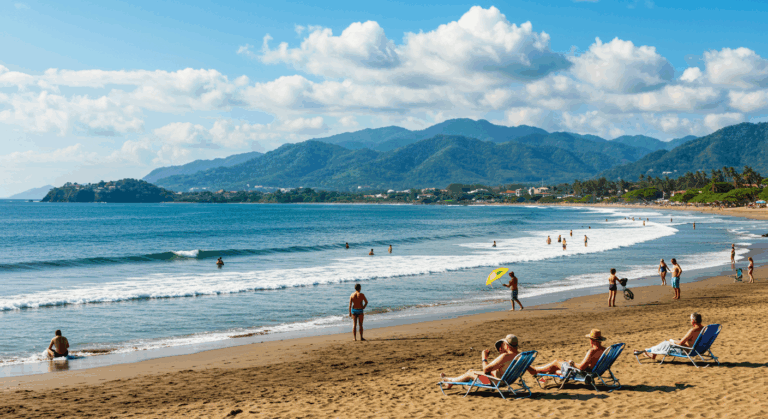When’s the best time to visit Costa Rica? That depends on your travel style. If you’re chasing sunshine, wildlife, or perfect waves, this guide breaks it all down for you. We’ll walk you through the dry and rainy seasons, month-by-month weather patterns, and how regional differences from the sunny Pacific to the lush Caribbean can shape your trip.
Want fewer crowds, better deals, or peak nature experiences? You’ll find clear answers here, along with tips to match your plans to the perfect time of year. Let’s make sure your Costa Rica vacation is unforgettable from start to finish.
Understanding Costa Rica’s Seasons
Costa Rica doesn’t follow the traditional four-season pattern. Instead, it experiences two main seasons:
Dry Season (December to April)
Known locally as “verano” or summer, this is the sunniest and most popular time to visit.
- Weather: Clear skies, warm temperatures, and little rain especially on the Pacific coast.
- Best for: Beach days, outdoor adventures, and family travel during holidays.
- Things to Note: Higher prices and larger crowds, particularly around Christmas, New Year, and Easter.
Rainy Season (May to November)
Often called the “green season,” this period brings daily showers and lush, vibrant landscapes.
- Weather: Mornings are generally sunny; rain tends to fall in the afternoons or evenings.
- Best for: Budget-friendly travel, wildlife watching, and a quieter experience.
- Things to Note: Some remote areas may have muddy roads or limited access during heavy rain.
If you want a private, relaxing day on the water with family or friends, book your Deluxe Private Catamaran in Costa Rica today.
Month-by-Month Breakdown
Knowing what each month brings can help you time your trip perfectly.
- January – March: Peak dry season. Expect sunshine and ideal beach conditions.
- April: Hot and dry, great for beach lovers but can be scorching inland.
- May – June: The rainy season begins, but mornings are still clear. Prices start to drop.
- July – August: A mid-season dry spell (known as “veranillo”) often occurs. Ideal for summer vacations.
- September – October: Wettest months on the Pacific coast, but surprisingly dry on the Caribbean side.
- November: Transition month. Rain begins to fade, and landscapes remain green and beautiful.
Best Time to Visit for Different Experiences
Every traveler’s looking for something different. Scroll down to find the best time to visit based on what you want to experience.
For Beach Lovers

Head to popular Pacific beaches like Tamarindo, Santa Teresa, or Manuel Antonio for sun-soaked days and gentle surf. Consider a scenic catamaran tour to round out your beach experience.
If you’re a beach lover looking for a fun way to explore the coast, hop on our shared catamaran tour in Costa Rica.
Learn more about Best Beaches in Costa Rica.
For Wildlife Watching
Visit during the green season. You’ll have the chance to see nesting sea turtles, migrating whales, and more active wildlife in national parks.
For Budget Travel
May through early December offers lower prices on accommodations, tours, and flights. You’ll enjoy fewer crowds and more authentic experiences.
For Adventure Activities
Zip-lining, rafting, hiking, boat tours and volcano tours are available year-round. Just be prepared for slippery trails or higher water levels during the rainy season.
Holidays, School Breaks & Crowds
Timing your trip around school calendars and holidays can make a big difference.
- December Holidays: Busy but festive book early.
- Spring Break (March–April): High season with perfect weather, especially for families.
- Summer Vacation (June–August): Slightly quieter with good deals and moderate rainfall.
Regional Weather Differences
Costa Rica’s climate varies by region, so where you go matters just as much as when.
- Pacific Coast: Distinct dry and rainy seasons. Ideal for beach vacations during the dry months.
- Caribbean Coast: Wetter year-round, but tends to be drier in September and October.
- Central Valley (San José): Milder climate with cooler nights. Great base for exploring both coasts.
What to Pack for Costa Rica Trip
Your trip could be more enjoyable when you pack smartly. Discover packing essentials for your Costa Rica trip:
Dry Season Essentials
- Lightweight, breathable clothing
- Sunscreen and sunglasses
- Swimwear and flip-flops
- Hat and refillable water bottle
Rainy Season Must-Haves
- Waterproof jacket or poncho
- Quick-dry clothing
- Hiking boots or sturdy shoes
- Insect repellent and a small umbrella
Final Thoughts
There’s truly no bad time to visit Costa Rica. It all depends on the kind of experience you’re after. The dry season offers perfect beach weather and sunny skies, while the green season brings lush beauty, fewer crowds, and exciting wildlife. Whether you’re planning a romantic escape, an active family vacation, or a solo journey, understanding Costa Rica’s seasonal rhythms helps you travel smarter. Let this guide help you discover the best time to visit Costa Rica, and when you’re ready to hit the water, check out our catamaran tours for an unforgettable ocean adventure.
Frequently Asked Questions
What is the driest month in Costa Rica?
March is typically the driest, especially along the Pacific coast.
Is the rainy season a bad time to visit?
Not at all! It’s a beautiful time to explore the country with fewer tourists and greener scenery.
When is the cheapest time to travel to Costa Rica?
September and October usually offer the lowest rates on hotels and tours.
What’s the weather like in Costa Rica at Christmas?
December marks the start of the dry season. Expect sunny days and festive local celebrations.

